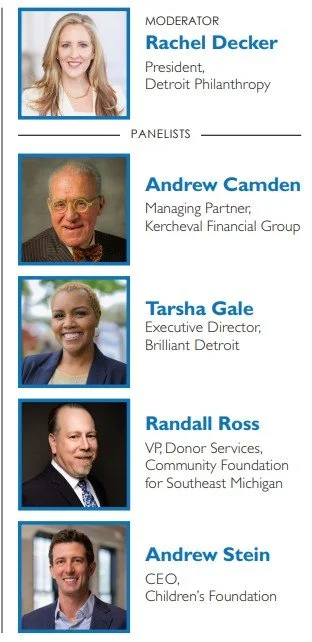Investing in Impact: Why Endowments Matter
On November 19, Detroit Philanthropy was pleased to host our final panel discussion of 2025: Investing in Impact: Why Endowments Matter. Andrew Camden, Tarsha Gale, Randy Ross, and Andrew Stein joined us for a robust and timely conversation on the essential role endowments play in strengthening long-term nonprofit sustainability.
The timing for this discussion could not be more relevant. In today’s increasingly uncertain funding landscape, nonprofits are navigating fluctuating donor behavior, rising operational costs, and economic instability. Against this backdrop, endowments have become more than a strategic advantage. They are a critical tool for safeguarding organizations through challenging periods and empowering leaders to plan boldly for the future.
Here are the key takeaways from the discussion:
Endowments provide permanent capital and long-term stability.
Endowments serve as a perpetual financial resource, generating annual support regardless of economic fluctuations. This permanent capital allows nonprofits to respond to unpredictable revenue cycles, support core programs even during downturns, and strategically invest in new opportunities when conditions are strong. Over time, an endowment becomes one of the most reliable and mission-aligned income streams an organization can build.
Endowments allow organizations to operate from a position of strength rather than urgency.
Without stable funding, nonprofits are often forced to make reactive decisions, resulting in the need to cut programs, delay growth, or reallocate staff. An endowment creates breathing room, giving leaders the ability to prioritize long-term impact over short-term crises. When financial pressures ease, organizations can stay focused on mission delivery, strategic growth, and deeper community engagement.
Endowments signal permanence and inspire donor confidence.
A well-structured endowment communicates that the organization is committed to serving its community for generations. Donors are more likely to invest in a mission that demonstrates long-term planning, fiscal responsibility, and staying power. Endowments become a powerful message to supporters: “We’re not just here today….we’re building for tomorrow.”
Clarity is the first step in any endowment conversation.
Before engaging donors or partners, organizations must articulate why an endowment matters. This includes defining the mission, the impact being delivered, and the strategic reasons the organization needs to exist for decades to come. Being able to clearly explain how an endowment supports future stability, program excellence, and community impact builds a stronger case for support.
Board and staff commitment is essential for successful endowment development.
Creating an endowment requires leadership alignment, including a board that understands the purpose, approves the structure, and champions the effort. Staff must also be prepared to dedicate time and energy to long-term donor education, stewardship, and planned giving outreach. Endowment building is not a short-term campaign. It is a sustained, organization-wide commitment.
Organizations must be prepared when partnering with institutions that manage or create endowments.
Entities such as community foundations and financial partners will require clear and accurate information to help establish an endowment. This includes leadership bios, governance structures, financial statements, annual fundraising goals, and multi-year projections. A board resolution authorizing the creation of an endowment is often a key step. Being prepared demonstrates professionalism and helps ensure the endowment is set up properly from the beginning.
Endowment funding should complement, not replace, annual or campaign giving.
A common misconception is that endowment fundraising competes with annual fund or special project support. In reality, endowment gifts typically come from different donor motivations, including legacy planning. It’s critical to communicate that the endowment is an additional opportunity for investment, not a substitute for the organization’s current year needs. Educating donors on the diverse ways to contribute is essential.
Small, consistent gifts play a major role in endowment growth.
Many people assume endowments are built exclusively through million-dollar bequests or contributions from wealthy donors. But most endowments grow through steady, modest gifts given over time. Donors who give $100–$500 annually and maintain that commitment over decades often become some of the most loyal supporters and may eventually include the endowment in their estate plans. Consistency builds culture, and culture builds endowments.
Frequent communication is key to endowment sustainability and growth.
Donors should hear about the endowment regularly. Sharing updates, success stories, impact, and testimonials helps donors understand how their long-term gifts make a difference. Ongoing communication keeps the endowment visible, reinforces its purpose, and encourages supporters to consider how they might participate in or expand its impact over time.
It’s important to be informed.
There are several local resources available to help you learn more.
Special thank you to our panelists:
Andrew Camden, Managing Partner, Kercheval Financial Group
Tarsha Gale, Executive Director, Brilliant Detroit
Randall Ross, VP, Donor Services, Community Foundation for Southeast Michigan
Andrew Stein, CEO of the Children's Foundation
Be sure to purchase tickets early for our next event! We often sell out quickly.

